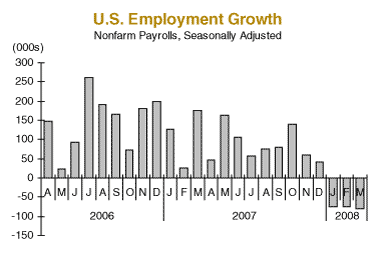|
April 9, 2008
Down Right Ugly
Written by Jeff Thredgold, CSP, President, Thredgold Economic Associates
An ugly March employment report, combined with substantial downward revisions to previously released employment data of January and February, strongly suggest that the U.S. economy is in the clutches of recession. In addition, employment data of coming months is likely to be anywhere from limited gains to down right ugly losses.
The Bureau of Labor Statistics arm of the U.S. Department of Labor provided the following ugly news on Friday morning, April 4…
• Their estimate that total employment fell by 80,000 jobs in March, the worst monthly decline in five years
• Prior estimated losses in both January and February were revised lower by a combined 67,000 jobs
• The estimated net decline of 232,000 jobs during 2008’s first quarter was a painful contrast to the estimated modest rise of 241,000 net new jobs during 2007’s final quarter
 |
• The nation’s unemployment rate jumped from February’s 4.8% rate to a two-and-a-half year high of 5.1%. Note: February’s surprising 4.8% jobless rate (versus 5.0% in December and 4.9% in January) was tied to a rise in the number of people leaving the labor force, versus additions to employment. People who leave the labor force and are no longer seeking employment are not considered unemployed
• Private sector employers cut 98,000 jobs during March, the fourth monthly decline in a row. A rise of 18,000 government jobs softened the overall blow just a bit
• Goods-producing employment dropped by 93,000 net jobs in March
• Manufacturing payrolls dropped by 48,000 in March, matching the largest monthly declined in nearly five years. Half of the decline was tied to a strike in the automotive sector, which has idled roughly half of General Motors’ work force
• Construction payrolls plunged by 51,000 during the month, following a loss of 37,000 jobs in February. While losses in new home construction employment are par for the course of a serious housing challenge in the U.S., employment losses in the commercial construction sector are becoming more worrisome
• Service-providing employers, which account for nearly six of every seven jobs in the American economy, added a measly 13,000 net new jobs in March. The 13,000 net rise was one-tenth of the average 130,000 monthly gain in service employment during 2007
• One bright spot was the 42,000 net rise in education & health services employment during the month
• As noted previously, the government sector added 18,000 net new jobs during March
• The leisure & hospitality sector also added 18,000 net new jobs during the month, while the professional & business services sector lost a painful 35,000 jobs
• Retail trade employment fell by 12,000 jobs during March
• The average hourly wage rose five cents (up 0.3%) to $17.86 hourly. The 3.6% rise in hourly earnings during the past year slightly lags the 4.0% rise in the Consumer Price Index for the most recent 12-month period
Any good news in the March report?
…a little here and there
The average work week increased slightly to 33.8 hours, up 0.1 hours versus the prior month’s 33.7 hours. While seemingly insignificant, the rise equates to a rise of more than 400,000 jobs in an economy where non-farm employment is nearly 138 million people.
The many-times-ravaged-or-under-pressure American farm sector is doing very well in many cases, especially those raising corn, soybeans, and wheat.
On the other hand, those farmers trying to feed chicken, beef, and hogs with expensive corn and beans are struggling, as are millions of consumers domestically and around the world who are paying high prices for basic food commodities.
How Will The Fed Respond on April 30?
People who regularly follow actions by America’s central bank, the Federal Reserve, have focused on the aggressive cuts in the Fed’s critical federal funds rate of the past seven months. The Fed has sliced its key rate from the 5.25% level (in effect from late June 2006 through mid-September 2007) to the current level of 2.25% in play since March 18, 2008.
In addition Fed Chair Ben Bernanke, along with U.S. Treasury Secretary Paulsen and their chief lieutenants, have been sailing through uncharted waters in recent weeks and months in regard to enhancing credit flows and rebuilding credit market confidence both domestically and around the globe. While many applaud their actions as necessary in a time of global credit market anxiety, others decry their actions as enormously costly and near voodoo in terms of whatever precedents are set for the next time financial markets freeze up.
Widespread employment weakness in March, combined with the sharp downward revisions to data of the two prior months, has heightened the odds that the Fed will respond with another cut on April 30. Many who thought a 0.25% cut (if any) would occur on April 30 now see rising odds of a 0.50% cut on or before that day. Such a 0.50% cut would take the federal funds rate to 1.75%.
It is important to note that the Fed DOES NOT know at this time what, if any, actions might occur later this month. Ebbs and flows of confidence in both credit markets and equity markets in coming weeks will help paint a better picture as to what might be expected two to three weeks from now.

Civil Service
While the recent focus is on recent American employment weakness, other factors will move center stage over the next few years, including a major government crisis impacting “civil servants” (Business Week).
The government’s Office of Personnel Management noted recently that more federal employees are expected to retire in 2008 than in any previous year, with 2009 likely to see even greater retirements. Within four years, more than 50 percent of the current federal government workforce, including 90 percent of senior management and a third of all government scientists and economists, will likely be gone—leaving a quarter million jobs in their wake.
At least in regard to senior managers and scientists, that presents some real challenges. Expect to see more in the way of government signing bonuses, longevity bonuses, and other steps to both keep current workers on the job and entice young workers to government jobs…
…a challenge wherein most young workers see greater opportunities in the private sector
• Email this article to a friend
• Learn about econAmerica, Jeff’s latest book
|
|
Subscribe to the Tea Leaf
Like what you just read? Have Jeff Thredgold’s Tea Leaf emailed to you free each week. Subscribe today.
|
|
|

“Tea”sers
Actually heard in a courtroom
-And where was the location of the accident?
-Approximately milepost 499.
-And where is milepost 499?
-Probably between milepost 498 and 500.
The youngest son, the twenty-year old, how old is he?
• Send us a “Tea”ser

“Tea”stimonial
“You are a meeting planner’s dream. Not only were you rated the best speaker by our convention attendees, but also numerous survey responses that were received indicated that one of the best things about this convention was Jeff Thredgold. You can be assured that I will recommend you to others.”
—Cathy Kelly, VP, Iowa Independent Bankers
• More testimonials
Invite Jeff Thredgold to speak at your next conference, meeting, or client function
If you like the Tea Leaf, you’ll love Jeff Thredgold’s live presentations. Jeff takes your audience on a timely, engaging, and entertaining tour of the U.S. economy and financial markets. Debunking some of today’s most common economic myths, he offers a clear picture of how the American economy is really performing and what that means for the future of your finances.
• Watch video clips of a Jeff Thredgold presentation.
• Download more information that you can e-mail to other decision makers.
• Tell us about your event using our online form and we will contact you. Or, is there an individual in your organization you would like us to contact?
• Give us a call at 1-888-THREDGOLD (847-3346) to ask about Jeff’s availability and pricing for your event, or for any other information.
|

